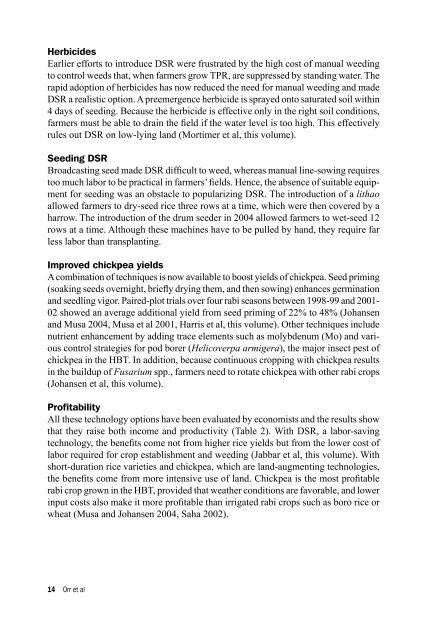Download (2461kB) - University of Greenwich
Download (2461kB) - University of Greenwich
Download (2461kB) - University of Greenwich
- No tags were found...
Create successful ePaper yourself
Turn your PDF publications into a flip-book with our unique Google optimized e-Paper software.
HerbicidesEarlier efforts to introduce DSR were frustrated by the high cost <strong>of</strong> manual weedingto control weeds that, when farmers grow TPR, are suppressed by standing water. Therapid adoption <strong>of</strong> herbicides has now reduced the need for manual weeding and madeDSR a realistic option. A preemergence herbicide is sprayed onto saturated soil within4 days <strong>of</strong> seeding. Because the herbicide is effective only in the right soil conditions,farmers must be able to drain the field if the water level is too high. This effectivelyrules out DSR on low-lying land (Mortimer et al, this volume).Seeding DSRBroadcasting seed made DSR difficult to weed, whereas manual line-sowing requirestoo much labor to be practical in farmers’ fields. Hence, the absence <strong>of</strong> suitable equipmentfor seeding was an obstacle to popularizing DSR. The introduction <strong>of</strong> a lithaoallowed farmers to dry-seed rice three rows at a time, which were then covered by aharrow. The introduction <strong>of</strong> the drum seeder in 2004 allowed farmers to wet-seed 12rows at a time. Although these machines have to be pulled by hand, they require farless labor than transplanting.Improved chickpea yieldsA combination <strong>of</strong> techniques is now available to boost yields <strong>of</strong> chickpea. Seed priming(soaking seeds overnight, briefly drying them, and then sowing) enhances germinationand seedling vigor. Paired-plot trials over four rabi seasons between 1998-99 and 2001-02 showed an average additional yield from seed priming <strong>of</strong> 22% to 48% (Johansenand Musa 2004, Musa et al 2001, Harris et al, this volume). Other techniques includenutrient enhancement by adding trace elements such as molybdenum (Mo) and variouscontrol strategies for pod borer (Helicoverpa armigera), the major insect pest <strong>of</strong>chickpea in the HBT. In addition, because continuous cropping with chickpea resultsin the buildup <strong>of</strong> Fusarium spp., farmers need to rotate chickpea with other rabi crops(Johansen et al, this volume).Pr<strong>of</strong>itabilityAll these technology options have been evaluated by economists and the results showthat they raise both income and productivity (Table 2). With DSR, a labor-savingtechnology, the benefits come not from higher rice yields but from the lower cost <strong>of</strong>labor required for crop establishment and weeding (Jabbar et al, this volume). Withshort-duration rice varieties and chickpea, which are land-augmenting technologies,the benefits come from more intensive use <strong>of</strong> land. Chickpea is the most pr<strong>of</strong>itablerabi crop grown in the HBT, provided that weather conditions are favorable, and lowerinput costs also make it more pr<strong>of</strong>itable than irrigated rabi crops such as boro rice orwheat (Musa and Johansen 2004, Saha 2002).14 Orr et al
















